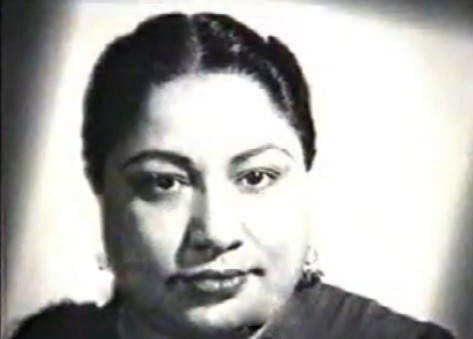The so called vintage era saw the rise of other successful singers like Ashok Kumar, Surendra, Amirbai, Zohrabai Ambalewaali, Noor Jahan, Suraiya and Shamshad Begum besides K. L. Saigal, Pankaj Mullick, K. C. Dey and Jagmohan.

Ashok Kumar

Surendra

Zohrabai Ambalewaali

Noor Jahan

Suraiya

Shamshad Begum
https://www.youtube.com/watch?v=tzcUgBGGSbw
https://www.youtube.com/watch?v=BmKTDj1BGmM
https://www.youtube.com/watch?v=3IVykPTPGyE
https://www.youtube.com/watch?v=KZBO9UzeYR4



Ashok Kumar

Surendra

Zohrabai Ambalewaali

Noor Jahan

Suraiya

Shamshad Begum
https://www.youtube.com/watch?v=tzcUgBGGSbw
https://www.youtube.com/watch?v=BmKTDj1BGmM
https://www.youtube.com/watch?v=3IVykPTPGyE
https://www.youtube.com/watch?v=KZBO9UzeYR4
One of the best song I remember that Ashok kumar sung is from the movie ''Khoobsurat''(1980) , composed by R D Burman.
https://www.youtube.com/watch?v=WSKVIfIvSc0
Post independence, India saw a new breed of male singers like Mohd. Rafi, Mukesh, and Kishore Kumar. Noor Jahan immigrated to Pakistan after independence clearing the way for the new breed of female singers like Lata Mangeshkar, Geeta Dutt, Asha Bhosle, new breed of music composers like Shankar Jaikishan, OP Nayyar, Madan Mohan, S. D. Burman also came into the limelight changing the music style with introduction of new instruments and arrangement.
Indian music in movies came a long way from the first song that was recorded live with an harmonium and tabla for Alam Ara the first talkie or sound film in 1931 and sung by Wazir Mohammed Khan to K. L. Saigal to Mohammed Rafi, what a journey it was.
The Indian Cinema journey started with the first full length silent film in Marathi, Raja Harishchandra produced by Dadasaheb Phalke in 1913, the female roles in the movie were played by male actors. Thereafter it took 18 years to transit from silent to talking film and the first Indian talking film was Alam Ara released on 14 March 1931 followed by Bhakta Prahlada on September 15, 1931 in Telugu and Kalidas in Tamil was released on October 31, 1931. Ardeshri Irani produced Alam Ara and H. M. Reddy produced Bhakta Prahlada and Kalidas was produced by Ardeshri Irani and directed by H. M. Reddy. One can say the talkie movies were pioneered by Ardeshri Irani and H. M. Reddy.
The period from late 1940 to 1960 was the “Golden Age” of Indian cinema when some of the most critically acclaimed Hindi Commercial films of all times were produced, Guru Dutt’s Pyaasa (1957) and Kaagaz ke Phool (1959), Raj Kapoor’s Aawara (1951) and Shree 420 (1955), Mehboob Khan’s Mother India (1957), V. Shantaram’s Do Ankhen Barah Haath (1957), Bimal Roy’s Madhumati (1958) and K. Asif’s Mughal-E-Azam (1960) to name a few made a mark and left a lasting impression on the Indian movie canvass.
Indian is the only country in the world that produces movies in over 13 languages catering to the different regions of the country. Over 1000 movies are produced every year in different languages with the highest number of movies produced in Telugu, Hindi and Tamil languages.
Songs are an integral part of the movies in India, there are very few movies made without songs and could be counted on one hand (Probably). Only two movies come to mind that had no songs in them, Kanoon in 1960 and Ittefaq in 1969, both produced by BR Chopra and both suspense thrillers. They say B. R. Chopra took it as a challenge when he was told that Indian movies contained nothing but songs when he attended a German Film Festival and made Kanoon. Ittefaq was shot in 28 days flat with superstar Rajesh Khanna and Nanda and was directed by BR’s brother Yash Chopra and based on English film Signpost to Murder. Though these two movies did well at the box office there is nothing much to talk about besides being song-less movies.
Movies are remembered by its songs and as mentioned in my earlier posts there are movies which was a “Hit” at the box office mainly because of the songs, movies had to have eight to ten songs in them and film makers found different situations or created one to insert the songs in the movie. The music directors or composers are as much in demand as are the actors in the movies. It is very difficult to imagine a Hindi movies without songs.
Today Film songs has carved a niche of its own in the culture of India, one can say that besides Carnatic and Hindustani music there is a place for Film music too.It takes years of dedication and practice to learn the classic forms of Indian music but its very easy to learn and sing movie songs. Its the songs from movies that motivates and inspires us, its easy for a man to express his moods with the help of songs from movies. Movie songs has tremendous influence on us and without them our life is incomplete.

B. R. Chopra

Yash Chopra







